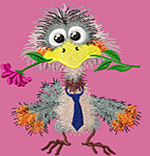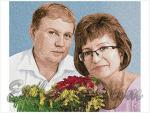Pages of Machine Embroidery History
The first embroidery machine
Doing any business it's helpful to know it's prehistory.
If to be talking about machine embroidery - it's interesting when and how had it appeared. For a beginner it seems that modern embroidery machines are direct successors of lockstitch sewing machines on which our mothers or grandmothers (and many of us) used to embroider in the running stitch technique. But that's not true. The very first specialized embroidery machine will be 200 years old in 2029!
Sometimes you may come across a discussion on forums and blogs of what's better: hand or machine embroidery? Hand embroidery supporters often offend machine embroidery in soulless and the absence of originality, in the way that every embroidered sample looks just the same as the previous one. Who knows, maybe in XIX also there were ladies who prefered only manual embroidery because of the same reason? There is nothing new under the sun..
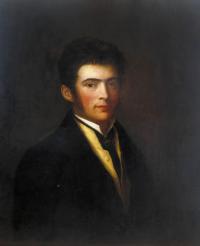 In 1829
In 1829
a famous French inventor Joshua Heilmann made the first hand embroidery machine for embroidering in the satin stitch. Just one year later, Franz Mange from St. Gallen (Switzerland) ordered two such machines , under the condition that he sold no other machine in Switzerland or its immediate surroundings without Mange's consent. However, Mange allowed the Maschinen-Werkstätte und Eisengießerey the production of such machines. Several machines were exported abroad, but without lasting success for the local industry.
 The new owner of the Mange's company at the end of Thirties of XIX together with his mechanic Anton Saurer improved the machinery such that the quality was now nearly equal to that of hand-embroidery. The first large machine embroidery factory was built in St.Gallen in 1840. In 1855 the machine was shown at the exhibition in Paris where it caused a stir. Since that time machine embroidery was widespread. In 1875 one could count around 3000 (1500 according to other sources) embroidering machines in the canton of St.Gallen alone.
The new owner of the Mange's company at the end of Thirties of XIX together with his mechanic Anton Saurer improved the machinery such that the quality was now nearly equal to that of hand-embroidery. The first large machine embroidery factory was built in St.Gallen in 1840. In 1855 the machine was shown at the exhibition in Paris where it caused a stir. Since that time machine embroidery was widespread. In 1875 one could count around 3000 (1500 according to other sources) embroidering machines in the canton of St.Gallen alone.
The principle of operation of this machine repeats the hand embroidering.
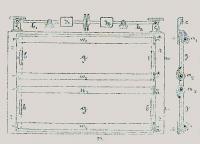 The machine consists of the frame (hoops) with the stretched fabric (g). The frame hangs vertically, so it ccan freely move both to vertical and horizontal directions.
The machine consists of the frame (hoops) with the stretched fabric (g). The frame hangs vertically, so it ccan freely move both to vertical and horizontal directions.
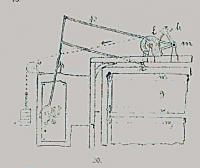 The movement is achieved with the system of levers, representing the pantograph, where worker conducts a picture, situated on the machine, with the handle.
The movement is achieved with the system of levers, representing the pantograph, where worker conducts a picture, situated on the machine, with the handle.
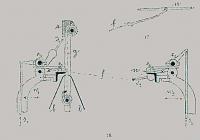 On the both sides there are carriage W1 and W2, which are moving closer and than moving away from the hoops and each supporting two or three rows of tweezers Z1, Z2, which in their turn are capturing needles n. The last ones have the needlepoints on both sides and the needle's eye is situated in the middle where a filament of the exact length is threaded.
On the both sides there are carriage W1 and W2, which are moving closer and than moving away from the hoops and each supporting two or three rows of tweezers Z1, Z2, which in their turn are capturing needles n. The last ones have the needlepoints on both sides and the needle's eye is situated in the middle where a filament of the exact length is threaded.
The work goes just like the embroidering on hoops. The carriage W2 with the clamped in it's tweezers Z2 needles has to be moved to the hoops that close that the needles pierce the fabric. Then to the protruding from the other side endings moves another carriage W1, tweezers Z1 which pierce the needles which by this time are releasing by the tweezers of the first carriage. Than the carriage W1 moves away from the fabric and the threads are dragging on the whole of theirs length. After that the hoops are moving to the new position and the worker moves the carrige Z1 closer to the fabric again, and what is more, the needles are thrusting in the new points, after what the work motion goes backwards.
Click on the picture to enlarge
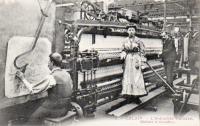 On the postcard of 1905 year (France, a work in a factory in Calais) -is a picture of the Heilmann's machine while working. The embroider is sitting on the left. He directs the pantograph which is moving along the picture's lines - we could call it an embroidery design nowadays. The pantograph transfers vertically stretched fabric into the right direction through a levers' system. With the right hand the embroider revolves a wheel which pushes fabric through the needles and he directs clips which lowers and holds needles with his leg. Such work needed not a few physical effort, that's why the embroider should be exactly a male.
On the postcard of 1905 year (France, a work in a factory in Calais) -is a picture of the Heilmann's machine while working. The embroider is sitting on the left. He directs the pantograph which is moving along the picture's lines - we could call it an embroidery design nowadays. The pantograph transfers vertically stretched fabric into the right direction through a levers' system. With the right hand the embroider revolves a wheel which pushes fabric through the needles and he directs clips which lowers and holds needles with his leg. Such work needed not a few physical effort, that's why the embroider should be exactly a male.
The assistant is standing on the right. She traces the needles work and eliminates threads' breaks. Pay your attention to the continuous line of spools of thread at her waist's level and at the bottom. You can judge about the amount of needles by the amount of spools.
So, the speed of such embroidering was equal to the speed of manual embroidering, the saving of time was in the fact, that one machine could be embroidering many patterns at once.
The one more revolutionary feature of inventing the machine embroidery was in the thing that if in other industries the appearing of a machine entailed appearance of a large factory, the machine embroidery was directed into small houses, cottage industry and in abandoned and remote corners. The embroidery machines were small in size and ordinary people could locate them at their houses or outbuildings. In 1880 in single states of Switzerland for every 20 residents was accounted one embroidery machine, so the whole villages were becoming the fabrics for machine embroidering.
The next milestone and breakthrough in the development of machine embroidery was the invention of the Schiffli embroidery machine in 1863. We will tell you about it in our next article.
